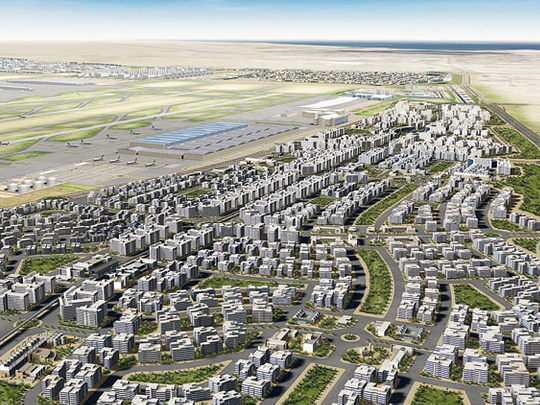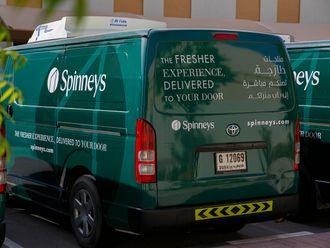
Dubai: Dubai's identity lies in its geographic location as a trading and transport hub.
When the $33 billion (Dh121.18 billion) Dubai World Central (DWC) project was launched over two years ago, confidence was high and the road looked smooth. Funding was expected to come from the city's growing popularity as a tourist destination and its burgeoning real estate sector.
DWC was mammoth compared to other projects the city had embarked upon in past years in its race to fame and development.
Unexpectedly, the financial crisis posed a serious speed-breaker in the government's ambitious plans. However, while many real estate projects have been scrapped, infrastructure and economic development has not lost its priority despite the financial issues the city continues to face.
DWC is among the priority projects, since it is expected to transform the city's transport and logistics sector.
This move comes as a realisation of Dubai Vision 2015 of His Highness Shaikh Mohammad Bin Rashid Al Maktoum, Vice-President and Prime Minister of the UAE and Ruler of Dubai. The development will reduce the emirate's dependence on real estate and make the economy more sustainable.
Several projects under the umbrella of DWC and Dubai Aviation City Corporation are under construction. Some are even near completion in its first phase, ahead of schedule.
Khalifa Al Zafein, Executive Chairman of Dubai Aviation City Corporation — DWC, revealed the project status to Gulf News in an exclusive interview.
Stretched over 140 square kilometres, DWC will be the largest urban, fully self-sustained project in the UAE when complete.
The master plan includes six interrelated developments: the world's largest airport, Al Maktoum International Airport, Dubai Logistics City, DWC Aviation City, DWC Residential City, DWC Commercial City and DWC Golf City.
The combined developments are designed to serve the city's aviation, tourism, commercial and logistics requirements up to 2050 and beyond.
Twice the size of Hong Kong island, the project will have a population of more than 900,000 working and living within its borders.
Still in its first phase, most of the infrastructure has been laid down and several construction contracts are in the pipeline.
"We are still receiving tenders and analysing them. It's going at an aggressive pace," Al Zafein said.
The investment that has already gone into the project is "no less than Dh17 billion" ($4.63 billion).
"We are also testing the market for the future phases. We are living in a time of difficulty now. Not because of what is happening in Dubai, but because there are a lot of future partners who are hesitating due to the economic situation," he said.
Regarding the entire infrastructure completion date, Al Zafein said that it is very difficult to answer.
"If you had asked me this two years ago, the story would've been very different. I would've told you that we would be ready by 2025 for the ultimate phase of the airport.
"Now, I cannot say that. We have to see how we can prolong the life of Dubai International Airport and take some of the overspill capacity to this airport" rather than having most of the airlines shift their base to the new location, he said.
Centrepiece
The centrepiece of DWC, seeing most of the $33 billion investment, is the Al Maktoum International Airport, with an ultimate annual capacity of over 150 million passengers and 12 million tonnes of cargo. The airport will have six parallel runways and as many concourses with a 91-metre air traffic control tower, the tallest freestanding ATC tower in the Middle East.
Its passenger terminal, a 75,000 square metre single level terminal, will be able to handle five million to seven million passengers per year when it begins operations in June.
"It will be ready soon," Al Zafein said, about the building. Physically, however, the infrastructure will be ready to handle flights months prior to the official launch.
"More or less, we are almost in full readiness to start operations. We have the choice to do it soon or by the summer as planned," he said.
Al Zafein said basic infrastructure for the airport and associated buildings is already in place and ready for operation. It includes the control tower, fire station, radars, airfields and flight systems.
Also complete is the first of five 4.5-kilometre CAT-III runways capable of handling the A380 superjumbo, and the authority is working on obtaining the licence to operate it.
The Dh1 billion runway is the first tender to be fully executed in the DWC project.
Al Zafein said that the runway would initially handle cargo operations, a few months earlier than the opening of the passenger terminal.
Meanwhile, the various airport readiness programmes that have been taking place for almost a year are in their final stages.
"For the first phase of the airport, the full infrastructure is developed. We started with a green field, which had nothing. No power, water, sewage, nothing whatsoever. That's a big challenge," he said.
Al Zafein said that to operate the airport, sufficient power and energy has been secured to serve the needs for the next few years.
"We have enough power, distribution and district cooling to operate the airport and we have a lot preserved for the future. We don't know how fast the growth in demand will be, but we will definitely cover the power needs for at least five to seven years to come, and this is with rapid growth," he said.
Al Zafein said that Phases 2 and 3 are being discussed.
"We are going through a lot of modelling and designing of the airport," he said, adding that 80 per cent of the design work is done and it could take a year to finish.
"When we launch tender [of construction] depends on the economic situation," he said.
The airport will be linked to Dubai International Airport via an express rail system and ultimately will be serviced by the Dubai Light Railway Network (Dubai Metro) for air cargo shuttle and for passenger transfer. Some 100,000 car parking spaces will be available.
Race to expand
Regional airports development and refurbishment projects under way are valued at Dh235 billion, centred on the $33 billion Al Maktoum International Airport in Jebel Ali, Dubai, according to Reed Exhibitions, organisers of Dubai Airport Show.
Within the GCC, Saudi Arabia's King Abdul Aziz International Airport at Jeddah is seeing a Dh40 billion expansion, while Qatar is seeing a similar investment in New Doha International Airport.
Bahrain is doubling its international airport with a Dh3 billion expansion project now complete.
Meanwhile, Oman adds another Dh11 billion to the count with six more airports and Kuwait brings Dh8 billion for its international airport as well.
Additionally, Africa will see Sudan spend Dh2 billion, Tunisia and Egypt add Dh3 billion each, with Dh2 billion in Morocco. Libya's airport project brings another Dh1 billion and South Africa plans to invest Dh2.6 billion.
India is on its way to a flurry of airport developments with 35 airport modernisations representing Dh36 billion of government funding and another Dh16 billion from private developers.
Pakistan and Sri Lanka will also bring business for industry suppliers with Sri Lanka's Dh2.25 billion new airport and Pakistan's investments of over Dh2.4 billion in new airports along with upgrades to existing ones.
- $33b total cost of the DWC project
- 150m number of passengers new airport will handle
- 12m tonnes of cargo it will handle annually
- 91m height of air control tower, highest in region













